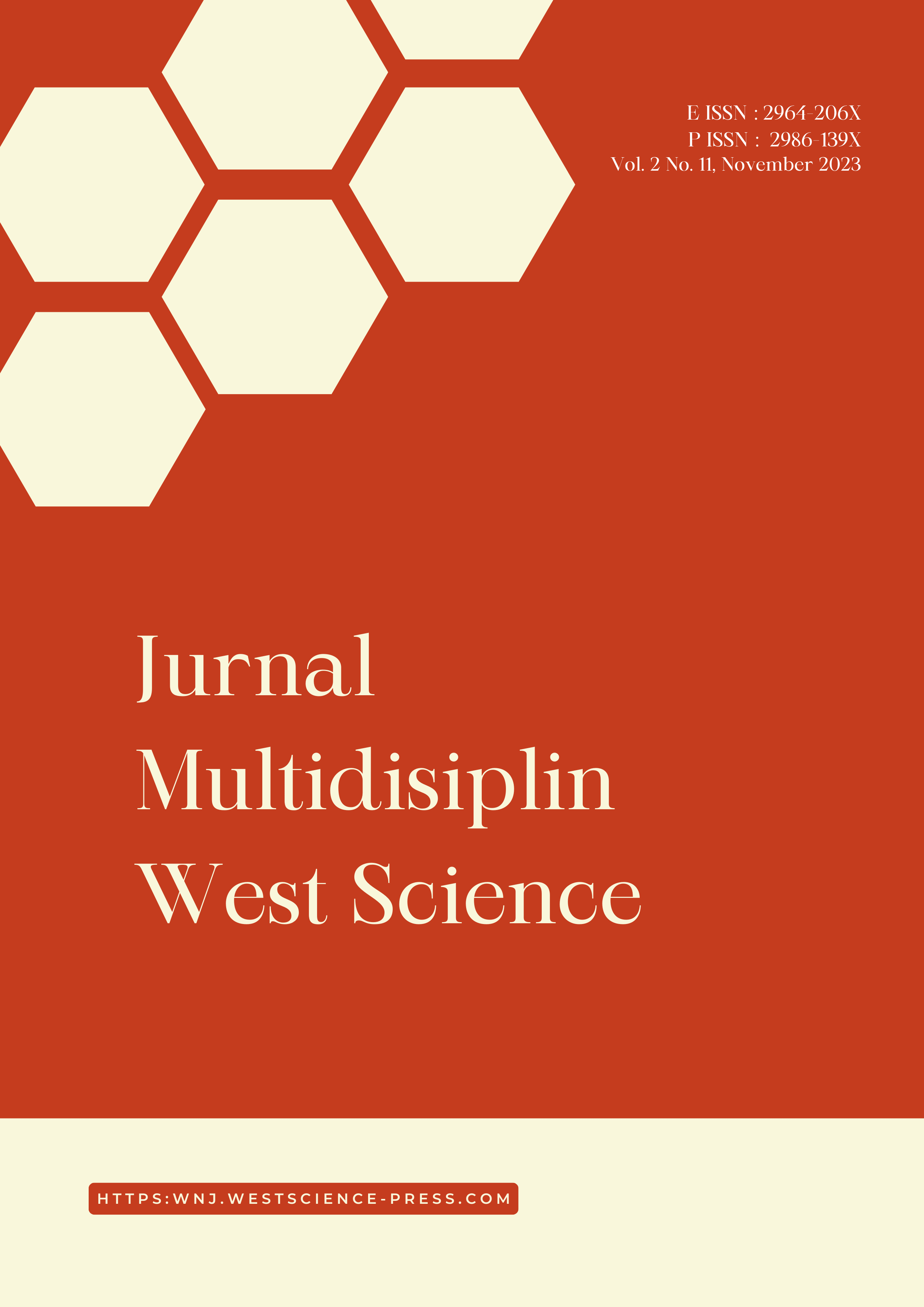Analisis Bibliometrik terhadap Efektivitas Teknologi Daur Ulang dalam Pengelolaan Limbah dan Pengurangan Pencemaran Lingkungan
DOI:
https://doi.org/10.58812/jmws.v2i11.782Kata Kunci:
Teknologi Daur Ulang, Pengelolaan Limbah, Pencemaran Lingkungan, Analisis BibliometrikAbstrak
Meningkatnya tantangan yang ditimbulkan oleh timbulan sampah dan pencemaran lingkungan membutuhkan pendekatan inovatif dan strategi komprehensif untuk pengelolaan sampah yang berkelanjutan. Studi ini menggunakan teknik analisis bibliometrik, dengan fokus pada kutipan utama dan kemunculan kata kunci, untuk menjelaskan lanskap teknologi daur ulang saat ini dalam pengelolaan sampah. Karya-karya yang berpengaruh, termasuk artikel penting oleh JR Jambeck dkk. tentang input sampah plastik ke laut dan analisis pemulihan limbah di industri penyamakan kulit, menjadi referensi dasar. Kemunculan kata kunci menunjukkan tema dominan seperti limbah elektronik, pengolahan air limbah, dan kebijakan, yang mencerminkan sifat interdisipliner dari penelitian pengelolaan limbah. Selain itu, kemunculan istilah yang lebih jarang seperti "Penilaian Siklus Hidup" dan "Ekonomi melingkar" menunjukkan potensi untuk eksplorasi di masa depan. Sintesis temuan menggarisbawahi keterkaitan tema-tema pengelolaan sampah, yang menekankan perlunya pendekatan holistik dan berkelanjutan. Wawasan yang diperoleh dari analisis ini dapat memandu para peneliti, pembuat kebijakan, dan pemangku kepentingan industri dalam mengatasi tantangan saat ini dan memajukan solusi inovatif untuk pengelolaan sampah yang berkelanjutan.
Referensi
Ahmed, M. I. B., Alotaibi, R. B., Al-Qahtani, R. A., Al-Qahtani, R. S., Al-Hetela, S. S., Al-Matar, K. A., Al-Saqer, N. K., Rahman, A., Saraireh, L., & Youldash, M. (2023). Deep Learning Approach to Recyclable Products Classification: Towards Sustainable Waste Management. Sustainability, 15(14), 11138.
Beesigamukama, D., Gómez-Brandón, M., & Tanga, C. M. (2023). Potential of entomocomposting toward soil pathogen suppression. Fate of Biological Contaminants During Recycling of Organic Wastes, 47–70.
Budiman, D., Iskandar, Y., & Jasuni, A. Y. (2022). Millennials’ Development Strategy Agri-Socio-Preneur in West Java. International Conference on Economics, Management and Accounting (ICEMAC 2021), 315–323.
Budjav, B. (2022). Evaluation of Environmental Pollution and Waste Management Strategies on the Ecosystem.
Crook, B. (2023). 147 Keynote: Bioaerosols Associated with Waste and Recycling–Balancing the Circular Economy with Occupational Health and Safety. Annals of Work Exposures and Health, 67(Supplement_1), i1–i2.
Duodu, M. G., Singh, B., & Christina, E. (2022). Waste management through bioremediation technology: An eco-friendly and sustainable solution. In Relationship Between Microbes and the Environment for Sustainable Ecosystem Services, Volume 2 (pp. 205–234). Elsevier.
Fuchs, M. C., Lorenz, S., Madriz Diaz, Y. C., Abend, T., Shaik Fareedh, J., de Lima Ribeiro, A., Arbash, E., Rasti, B., Beyer, J., & Röder, C. (2023). How can agile sensing improve recycling stream characterisation and monitoring for e-waste?-news from the HELIOS lab. EGU General Assembly Conference Abstracts, EGU-12298.
Iskandar, Y., Joeliaty, J., Kaltum, U., & Hilmiana, H. (2021). Bibliometric Analysis on Social Entrepreneurship Specialized Journals. Journal: WSEAS TRANSACTIONS ON ENVIRONMENT AND DEVELOPMENT, 941–951. https://doi.org/10.37394/232015.2021.17.87
Iskandar, Y., & Sarastika, T. (2023). Study of Socio-Economic Aspect and Community Perception on The Development of The Agricultural Area Shrimp Ponds in Pasir mendit and Pasir Kadilangu. West Science Journal Economic and Entrepreneurship, 1(01), 28–36.
Kong, J., Chua, G. A., & Yang, F. (2023). Firms’ cooperation on recycling investments in a three-echelon reverse supply chain. International Journal of Production Economics, 108959.
Loizia, P., Inglezakis, V., Navarro-Pedreño, J., Lasaridi, K., & Zorpas, A. A. (2019). Benchmarking indicators to assess the level of circular economy strategy in local level. 16th International Conference on Environmental Science and Technology, 4(7).
Mesquita, J. L. C., Gutberlet, J., de Araujo, K. P., Cruvinel, V. R. N., & Duarte, F. H. (2023). Greenhouse Gas Emission Reduction Based on Social Recycling: A Case Study with Waste Picker Cooperatives in Brasília, Brazil. Sustainability, 15(12), 9185.
Nainwal, P. (n.d.). Environmental Impact and Sustainable Solutions for Pharmaceutical Waste Management: An Empirical Investigation. European Journal of Molecular & Clinical, 5(01), 2018.
Rusmayadi, G., Supriandi, S., & Pahrijal, R. (2023). Trends and Impact of Sustainable Energy Technologies in Mechanical Engineering: A Bibliometric Study. West Science Interdisciplinary Studies, 1(09), 831–841.
Sahajwalla, V., & Hossain, R. (2023). Rethinking circular economy for electronics, energy storage, and solar photovoltaics with long product life cycles. MRS Bulletin, 1–11.
Tabaghchi Milan, S., Darbandi, M., Jafari Navimipour, N., & Yalcın, S. (2023). An Energy-Aware Load Balancing Method for IoT-Based Smart Recycling Machines Using an Artificial Chemical Reaction Optimization Algorithm. Algorithms, 16(2), 115.
Tembhare, S., & Bhanvase, B. A. (2023). Technological development in metal extraction processes from e-waste. In 360-Degree Waste Management, Volume 2 (pp. 221–253). Elsevier.
Trinandari Prasetyo Nugrahanti, N. (2020). Dysfunctional Audit Behavior and Sign Off Premature Audit Procedures: Case Study of Jakarta Public Accounting Firm.
Unegg, M. C., Steininger, K. W., Ramsauer, C., & Rivera-Aguilar, M. (2023). Assessing the environmental impact of waste management: A comparative study of CO2 emissions with a focus on recycling and incineration. Journal of Cleaner Production, 137745.
Xu, P., Tan, D. H. S., Jiao, B., Gao, H., Yu, X., & Chen, Z. (2023). A Materials Perspective on Direct Recycling of Lithium‐Ion Batteries: Principles, Challenges and Opportunities. Advanced Functional Materials, 2213168.
Yadav, P., Singh, J., Srivastava, D. K., & Mishra, V. (2021). Environmental pollution and sustainability. In Environmental sustainability and economy (pp. 111–120). Elsevier.
Unduhan
Diterbitkan
Cara Mengutip
Terbitan
Bagian
Lisensi
Hak Cipta (c) 2023 Muhammad Taswin, Ramdan Yusuf, Andi Haslinah, Hotnida Nainggolan

Artikel ini berlisensiCreative Commons Attribution-ShareAlike 4.0 International License.



















 Instagram
Instagram 